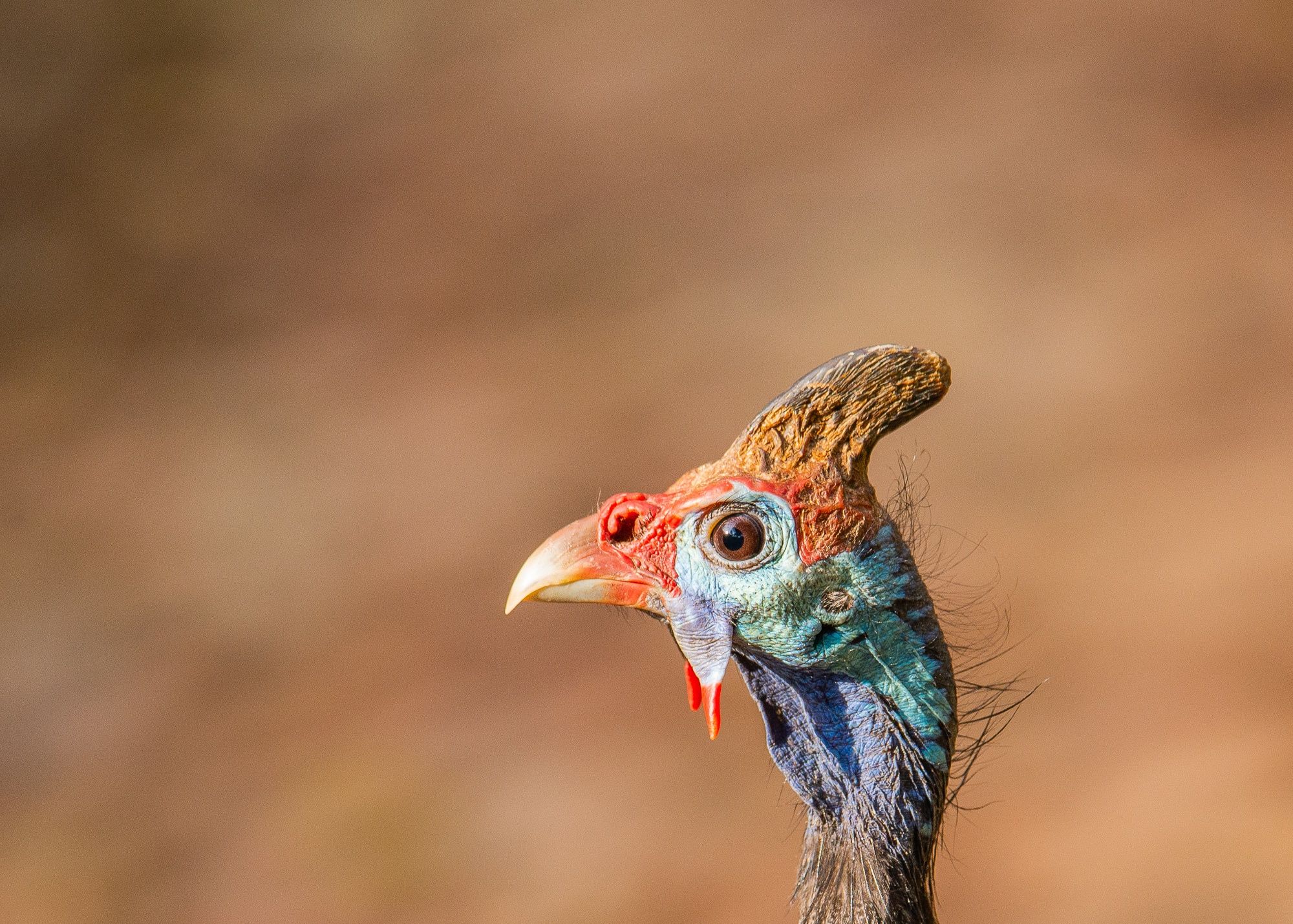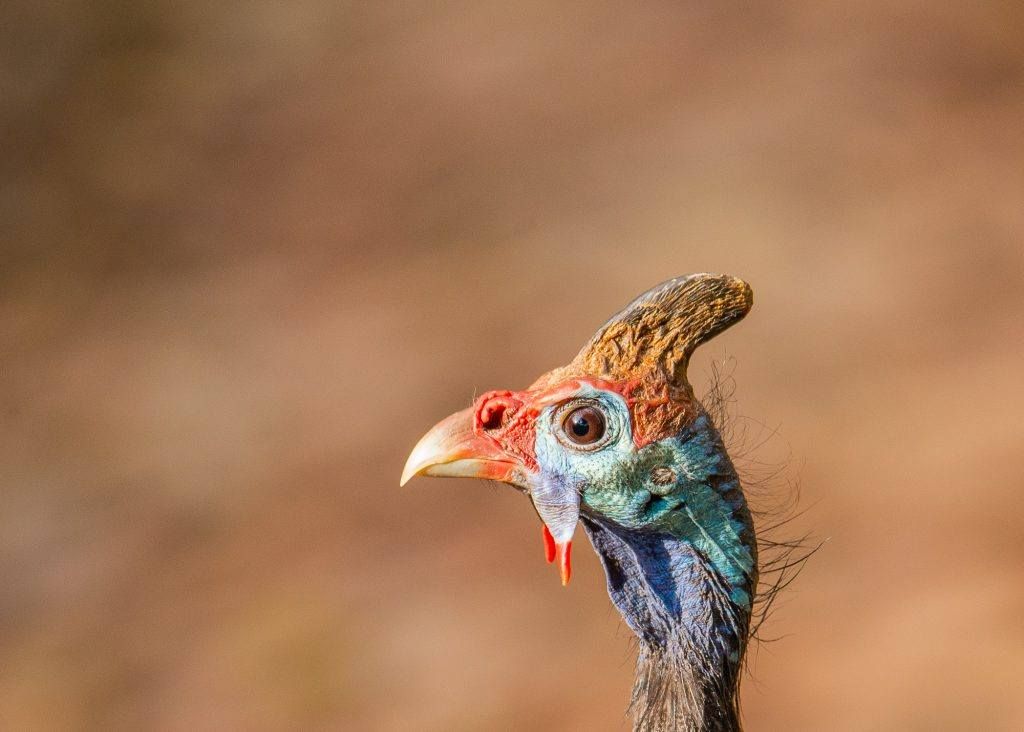Introduction
Why ‘know your subject’ when you are photographing birds? You can just find birds all around you and photograph them, can’t you? Sure! But you can add so much purpose, value, and reward to your photographed bird collection by knowing your subjects!
In this article we’re going to look at why it’s a good thing to know your subjects, and how you can achieve that.
Why is it advantageous to know your birds?
It will help you to get special images.
Knowledge of birds – or specific birds – raises your chance to take other than ‘just another photograph’ because it allows you to preempt their next move, or yours. I hope that the following examples would encourage you to get beyond the stage where you just take bird images for identification purposes.
Recommended Resource: Want to expand your shooting skills and master photography? Grab our set of 65 beautifully designed and printable Action Cards that will give you over 200 photography assignments to help you take your photography to the next level. Check it out here.
Images of Feeding Birds
An image of a feeding bird is just so much more able to evoke emotions from your viewers. A tiny bird with a worm in its beak will always lead to “aawwws” and “aaaaahs” from whoever is looking at it, especially from your female friends or children.
A raptor with a hyrax or another bird in its claws, still fighting for its life, will always lead to “ewwws” from the same audience and “wows” accompanied by multiple thumbs-ups from your male viewers. In short, it is just so much more rewarding than just another portrait seen a thousand times before.
Knowledge Tip:
- If you see a kingfisher on a perch above the water or a cormorant swimming, just be patient and keep watching it! It is certainly on the watch/hunt for food! It’s only a matter of time before you see some action!
- Some birds like kingfishers, bee-eaters, and shrikes return to the same spot after catching its prey from where it spotted it, more often than not!
- Most fish-eating birds prefer to kill their prey before swallowing it. This is for safety reasons as well to ease the swallowing process. Therefore, you have enough time to capture them.
- Fish-eating birds have to turn their prey in order to swallow them head-first to prevent the fins from blocking or getting stuck in their throats.
- Raptors like secretary birds, marabou storks, and ground hornbills walk through grasses for only one reason: they are hunting reptiles and snakes! If you’re patient enough, you will be rewarded with beautiful images.
- Kites hovering in one place are on the hunt. After catching prey, it will look for a tree close by to rip it apart and eat it.
- Smaller raptors watching larger ones as they are having a meal are most likely planning a steal! Keep watching it and keep your camera ready!
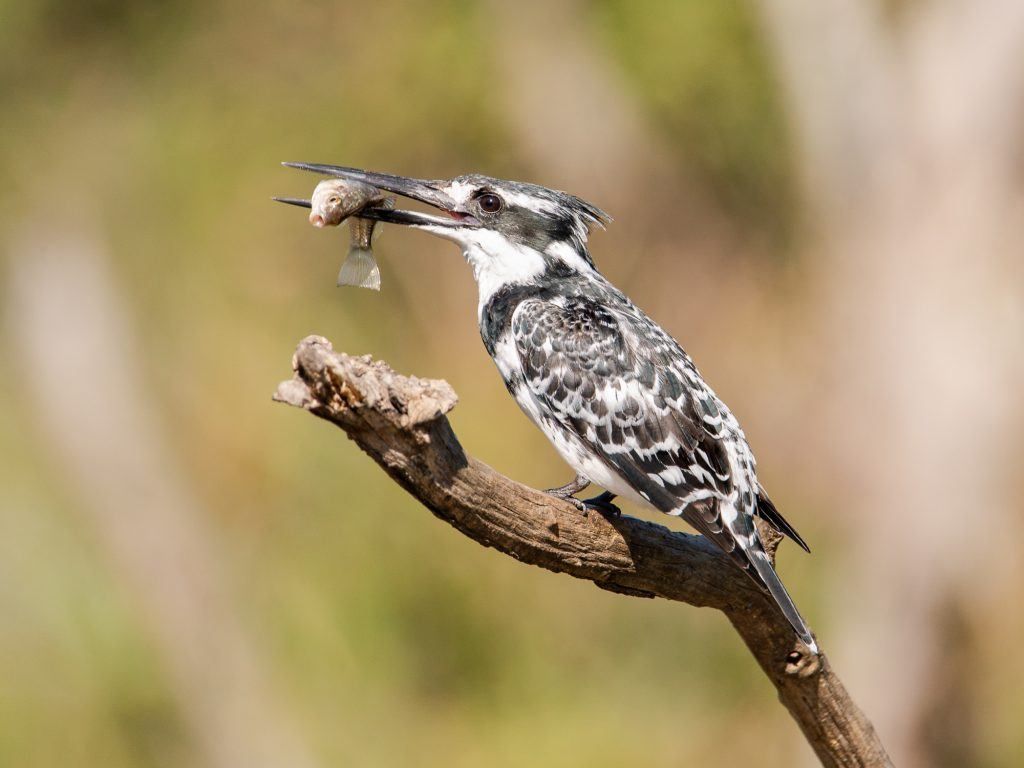
Nikon D600 + Tamron 150-600mm @ 600mm | f/6.3 | 1/1000s | 400 ISO | Beanbag | Photograph by Tobie Schalkwyk
Knowledge of birds – or specific birds – raises your chance to take other than ‘just another photograph’ because it allows you to preempt their next move, or yours.
Images of Birds Feeding Other Birds
So, why did I not call this section ‘Images of Birds Feeding their Chicks’? That is only one end of the spectrum. Sure, images of birds feeding their chicks are always a winner no matter who’s looking at it.
However, if you really want to feel your heart cringe, look at a tiny wagtail feeding a chick twice its size from one of the cuckoo species – you just know that you’re observing something very special. It’s not only a feeding; it’s a feeding with a history.
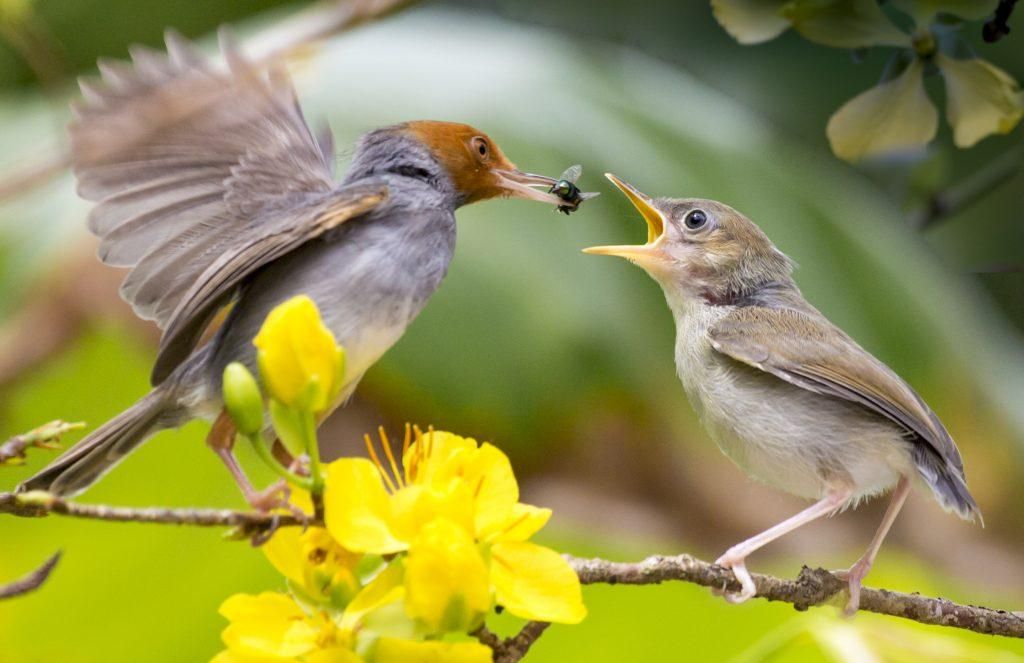
Photograph by Tobie Schalkwyk
You are filled with mixed emotions knowing that this chick’s biological mom relentlessly searched all nests in the vicinity a couple of weeks ago. It found this chick’s particular nest (already occupied by eggs) and laid its own (sometimes much bigger) egg amongst them when the parents to-be were away for as little as a few seconds.
If you really want to feel your heart cringe, look at a tiny wagtail feeding a chick twice its size from one of the cuckoo species – you just know that you’re observing something very special.
The cuckoo then hatched first (thanks to the rules set by Mother Nature) and kicked out the un-hatched eggs from the nest. It then pushed its poor unsuspecting surrogate parents to their limits in order to feed it more food than ever needed by its own chick’s much smaller tummies! Now compare all of the above to an ignorant photographer simply photographing ‘a bird feeding another bird’!
Knowledge Tips:
- Very few people are aware of the fact that when a chick falls out of a nest or loses its parents for whatever reason, other birds will react to its cry for food and feed it more often than not – even if it’s not of the same species!
- If you like the general “ooohs” and “aaaahs” in response to the uncommon shots mentioned above, then take one of these. It may even land you in the first spot of an international competition!
- Some bird species’ social bonds are very strong, to such a degree that siblings feed each other. These are always very special shots. You’ll have to know your birds well enough to distinguish juveniles from parents in order to do so.
- A lot of bird species have a dead give-away to identify a baby/sub-adult bird: prominent yellow gape flanges (like yellow lips) where their upper and lower beaks meet.
- Even in species where adults and sub-adult birds look identical, the young ones give their babyhood away by being very noisy as they beg for food when one of the parents are close by. The flapping or ‘shivering’ of wings often accompanies this.
- If you see birds with prey or other food items flying past on a regular basis, try to follow them. They are most likely feeding chicks and if so, will eventually lead you to their nest.
Note: Try to photograph this without their knowledge of your presence, or maintain a distance acceptable to them. Some birds will stop feeding when they know that you are too close as they do not want to reveal the position of their nests. If that happens in your case, retreat and let them feed their chicks in peace. The same is true for birds carrying nest-building material. You may just be lucky with an image or two showing their nest-building activity. What a bonus to know that they eventually return to the nest, and all you have to do is wait! Who knows, maybe you can snap their chicks later on in the same nest and write a story about it, starting with an image taken weeks earlier!
Images of Flying Birds
Images of flying birds not only show feather colors and patterns you would not see on a perching bird, but it is also quite challenging – and thus much more rewarding when you manage to take them successfully. Knowledge of when birds are going to take off and the most likely direction of their flight thereafter is a great asset, as is the most likely place where they will land and spend some time.
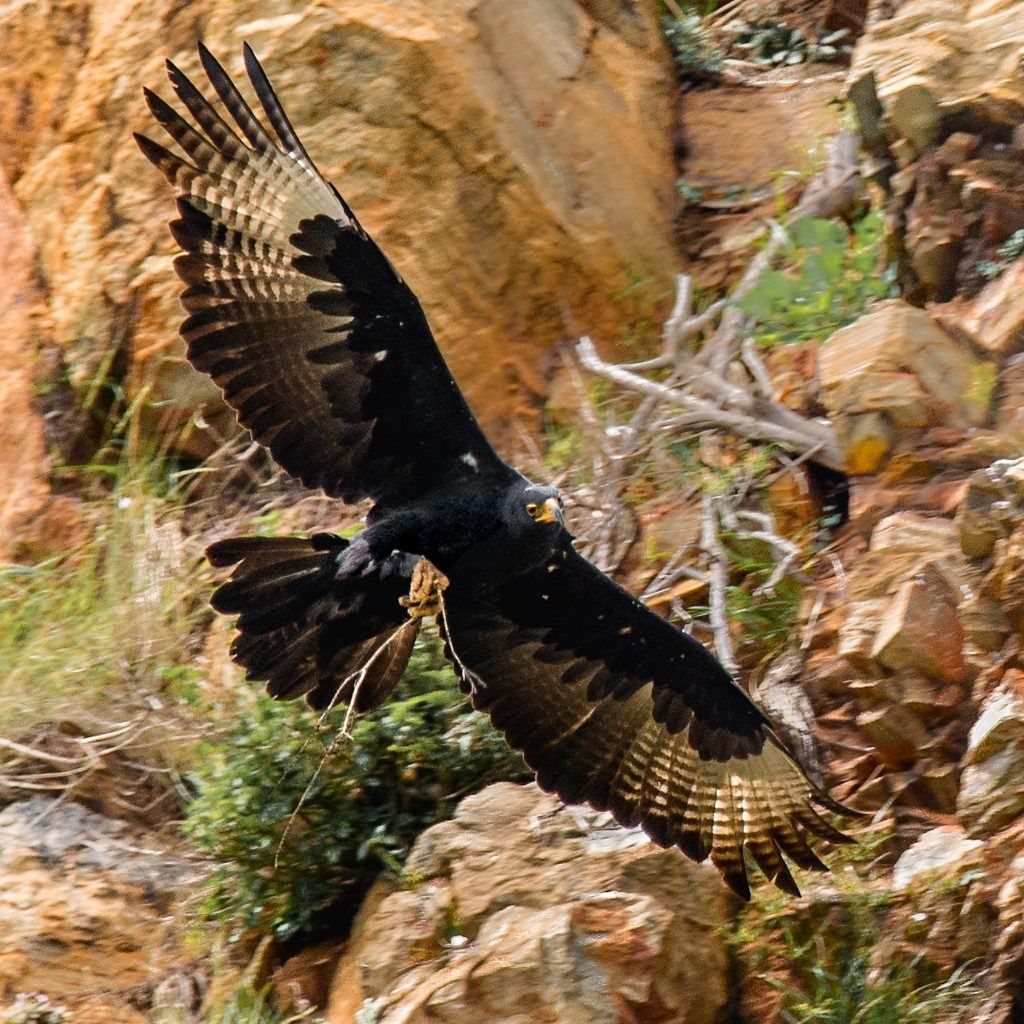
A Verreaux’s eagle caught bringing in nest-building material. One can get awesome shots just by waiting for their regular returns to the nest! Nikon D600 + Tamron 150-600mm @ 600mm | f/8 | 1/800s | 1000 ISO | Beanbag. Photograph by Tobie Schalkwyk
Knowledge Tips:
- One of the easier methods of capturing a flying bird is by keeping an eye on it. It usually indicates its intention to take off by defecating. Perhaps then zoom out a little in order to have enough space all around for the moment it takes off. Set your focus on it, and if you use back-button focus keep your finger on the focus button! When it takes off, let the continuous auto focus do its work!
- A shadow of a flying bird appearing on a dam’s water surface usually indicates an aquatic bird looking for a landing place. Be ready! A front shot just before and during landing is a bonus, but even a shot from the back usually reveals beautiful wing and tail feather patterns!
- Raptors often announce their presence above by means of calls, sending shivers down your spine! If you hear them, stop, look, and wait – it might just offer you a great shot from below!
- Larger raptors often get chased by smaller birds that feel endangered. These offer great action shots.
- Geese often announce their intention to take off by suddenly becoming very noisy for no apparent reason whilst flapping their wings. Set your focus in advance and be ready!
Images of Birds On/Under Attack
Knowing which birds are prone to attack from other birds may land you a few nice action shots to add to your bird collection. All you have to do when you see one of these birds is wait. It’s a matter of time before you see some action.
Knowledge Tips:
- Birds do not tolerate raptors perched close to them. They know that these birds are there for one reason: they’re looking for food! Keep an eye on them and be ready for action shots when they come under attack.
- Some raptors, like buzzards, love to investigate bird nests for chicks and eggs. If you see one perched close to (for example) weaver nests, be patient and ready! You might just see it going through gymnastic moves as it investigates these nests one by one, and you may see parent birds trying to fend it off with all they have!
- Some kites like to rob fish-eating raptors from pieces of their prey. If you see one watching another raptor having a meal, keep a close eye on it.
- If you see an owl in daylight, it’s a matter of time before it’s discovered by other birds. The attacks on them make for great action shots.
- Watch bird behavior. If a bird constantly looks up into the sky, it’s nervous of a raptor seen very recently – or it may even be spotting one at that very moment! Be ready to photograph some action, or see if you can spot the raptor yourself and photograph it!
Key Lesson: The knowledge of birds is a key factor in taking meaningful and significant images. It gets you out of the groove of just taking snapshots and allows you to find and identify unique and special birds/situations, followed by photographs that catch and hold the attention of your viewers.
Recommended Resource: Want to expand your shooting skills and master photography? Grab our set of 65 beautifully designed and printable Action Cards that will give you over 200 photography assignments to help you take your photography to the next level. Check it out here.
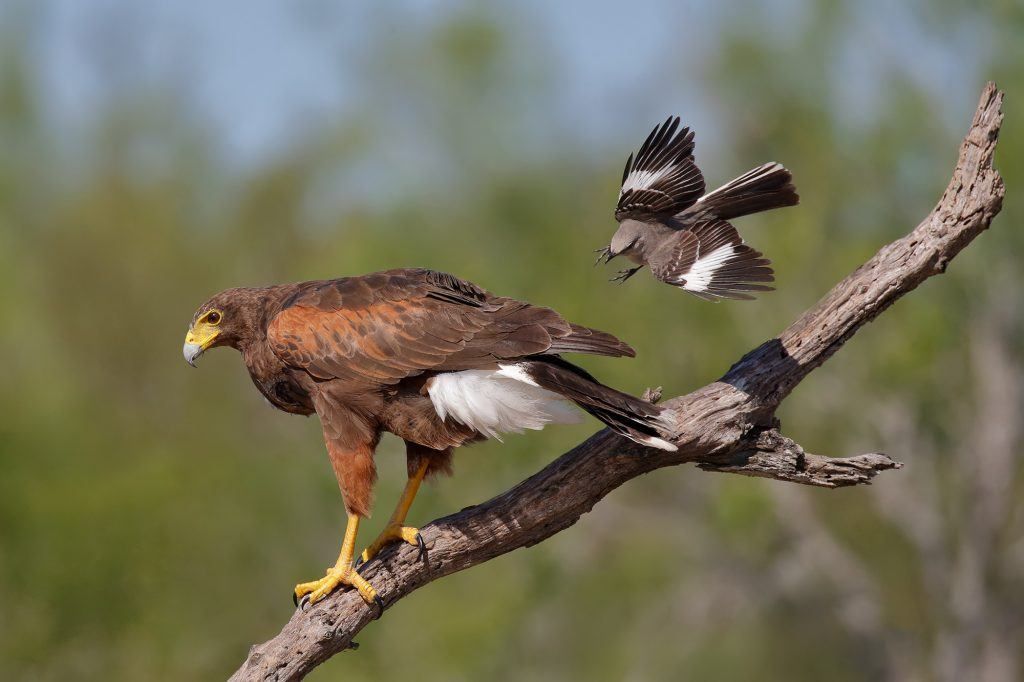
Mockingbird attacking a Harris’s Hawk. Canon 1Dx + Canon 600mm f/4 @ 503mm | f/8 | 1/3200s | 1250 ISO. Photograph by Anne Pacheco
Knowledge Helps You Identify and Find Birds
One of the most valuable ‘tools’ in bird photography is to know bird calls. There are few things as satisfying as hearing the call of a bird you still need to tick off on your bird list even before you see it, track it down, and then photograph it.
Sometimes you hear it and cannot find it but you know it’s there. It’s only a matter of time before you’ll run into it – if not today, then on another day!
Knowledge Tip: A lot of bird noise usually indicates some kind of predator close by. It may be a raptor or nest-robbing snake. It’s always worth an investigation!
What are some of the ways of learning bird calls specifically?
Books Which Include Bird Calls
Now, if ever there’s a great birthday or Christmas present, then this is it! Be sure that your family knows it!
There are paper-based books available on the market which include bird calls. Some of them include CDs/DVDs with calls. Some of them have a ‘pen’ and when you place its point on a particular bird image, it plays the call for you. It’s excellent learning material!
Do yourself a favor: search for ‘bird books with calls’ on Google and be prepared to be impressed!
Apps Which Include Bird Calls
These are covered in more detail in the ‘Where can I build up my knowledge of birds?’ section below.
Time in the Field
This is probably the most satisfying method of learning bird calls. Go out on bird shoots with bird photographer friends, or with Ornithologists or bird watchers (some people do not photograph birds but still study them).
Or spend time with this same group of people in bird hides. Then don’t be afraid to ask them about bird calls you’re not familiar with!
Key Lesson: The knowledge of bird calls can help you identify birds in the vicinity without seeing them first. It allows you to decide whether you want to follow up on the call and perhaps photograph a species, which you might not even have seen before, or ignore them and focus on a species you’re more interested in.
Where Can I Build Up My Knowledge of Birds
So, where can you extend your knowledge of birds? We are so fortunate to be living in an era when the world has become a very small place as far as the sharing of knowledge is concerned. “Google is your best friend” is not a fantasy; it’s a reality. But it’s not the only source of knowledge: there’s much more, and each has its own advantages.
Let’s look at a few sources of information:
The amount of knowledge available on Google boggles the mind. Once you know which bird you need information about, you just enter its name and click on the Search icon. Or maybe you want to know where to find birds so you search for “bird hides <country/area name>”.
Tip:
- Search for locations where logic dictates that birds are to be found. I have done a quick search on ‘bird hides North Carolina’ and the result at the top of the list is ‘Ten Bird Watching Hotspots in North Carolina.’ A good start!
- The link mentioned above is from birdwatchersdigest.com. Surely it’s worthwhile exploring this website. It will probably not only guide you toward birding hotspots but also have bird knowledge and facts.
- This search returned links to birding maps, bird watching venues, and conservancies. The world is your oyster!
Obviously by entering a bird name you will be served with numerous write-ups and facts about that particular bird. Usually Wikipedia pops up as one of the links. This is usually a very handy link as its content is written and maintained by knowledgeable hobbyists so the information is usually very up to date.
Social Media
Do not underestimate the immense value of social media groups focusing on bird photography. Obviously you would prefer membership of a group involved with birds in your local area or other areas of interest to you.
Do not underestimate the immense value of social media groups focusing on bird photography.
The advantage of groups such as these on Facebook is that the members post daily, up-to-date images of birds accompanied by location details. And you can chat to the members directly to get even more information about their posts!
Some of these groups organize tours, workshops, and other events which are invaluable for building your bird knowledge – and simply to enjoy your hobby!
Tip: I entered ‘birding North Carolina’ in Facebook’s search bar and one of the group names returned is ‘Birding in North Carolina.’ You will most likely have the same result by searching for groups in just about any area in the world!
Forum-Type Birding Sites
One of the best sites I’ve encountered is birdphotographers.net. Some of the best bird photographers around (IMHO) post to this site on a daily basis. Not only can you gain immense knowledge here about bird behavior and locations, but you can even enter your own bird images for constructive critiques.
A Google search for ‘birding forums’ returns a long list of birding forums. Find one that suits your needs best and learn by becoming an active member!
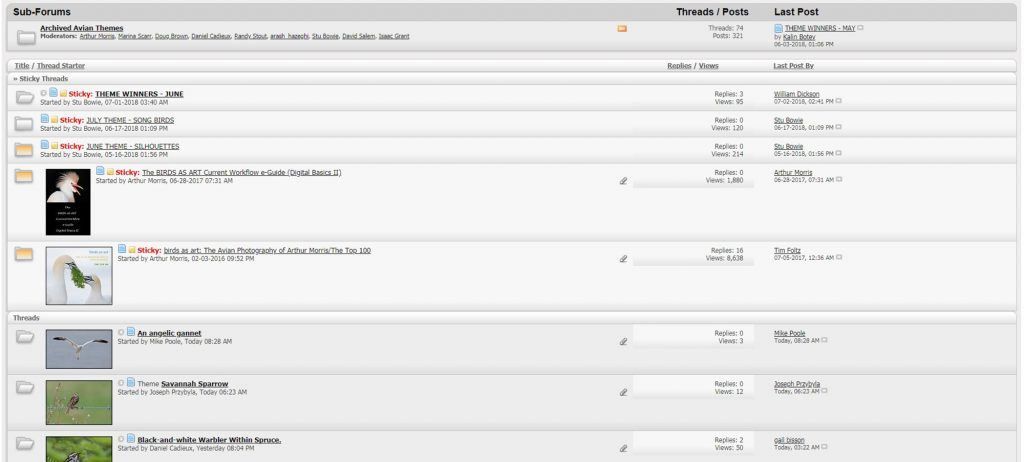
Screenshot by Tobie Schalkwyk
eBooks
Sites like Photzy are invaluable for downloading free (or paid) books about birds. The advantage of these books is that they have been written by someone currently photographing birds, so the information is up to date.
Sites like Amazon also have long lists of birding books, which you can download to your laptop, tablet/iPad, or cell phone. That means you always have it with you on your bird shoots.
Tip: Enter ‘birding eBooks’ in Amazon’s search bar and be impressed by the list of bird books available!
Bird Applications (Apps)
This is another great tool for bird photographers. Not only do they offer extensive knowledge about each bird in its library, but some apps even enable you to play back each bird’s call.
Just like eBooks, these apps can be downloaded to a range of devices including your cell phone. It’s literally like having a bird library in your pocket!
Tip:
- Enter ‘birding’ in Google Apps’ Search bar on your phone/tablet/ iPad and see the list of apps on offer.
- I’d recommend doing your homework first in terms of the best app for your purpose as some of them might be a little expensive. You would not be impressed if you buy an expensive app and it covers birds not really relevant to your area!

Photograph by Tobie Schalkwyk
Bird Books
One could argue that the printed format of bird books are becoming irrelevant with all of the other formats on offer. My paper-based book is still my preferred media, though, because nothing beats the clarity of printed bird images. It always occupies a space in either my camera bag or my laptop bag, and I consult it much more than the (great!) bird app on my tablet.
Tip: If you buy a bird book in printed format, make sure it’s up to date (the latest/most recent edition), that its images are of top quality, and that it covers birds of interest to you. That book will be your main source of information when identifying birds.
Don’t be stingy if a bird book is a little expensive, because next to your camera gear it will probably be the most important photographic investment you ever make.
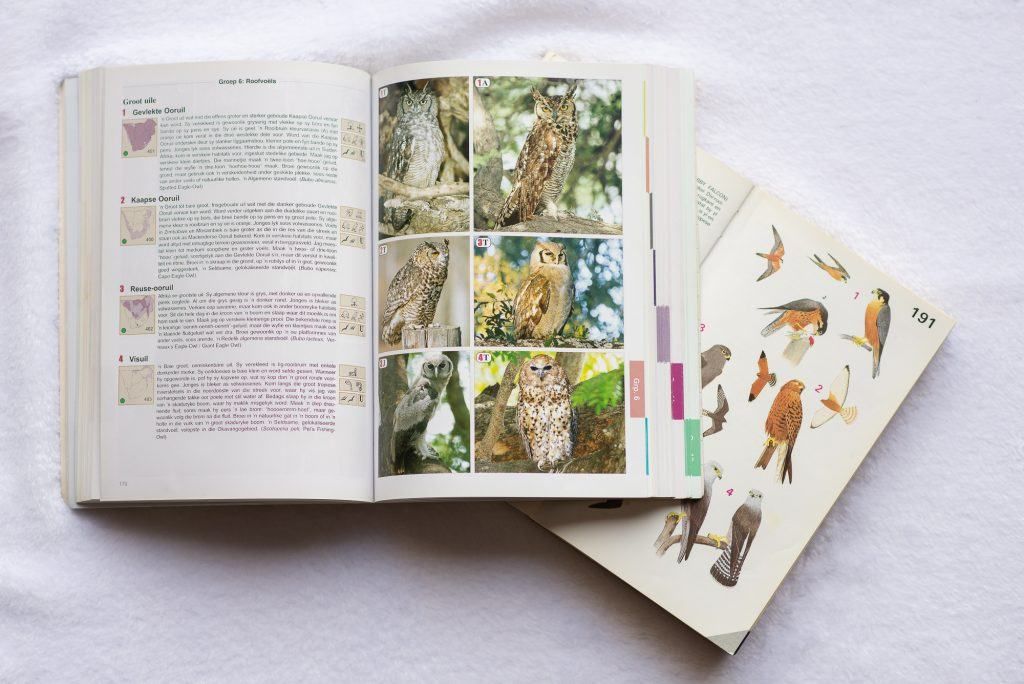
Photograph by Tobie Schalkwyk
Key Lesson: A vast database of bird knowledge is available in the marketplace. Some of it is free and readily available, and some of it comes at a price. Whatever knowledge you’re looking for, it’s there. Use it to your full ability. The more you get to know your birds, the higher the rewards – as reflected in your bird images.
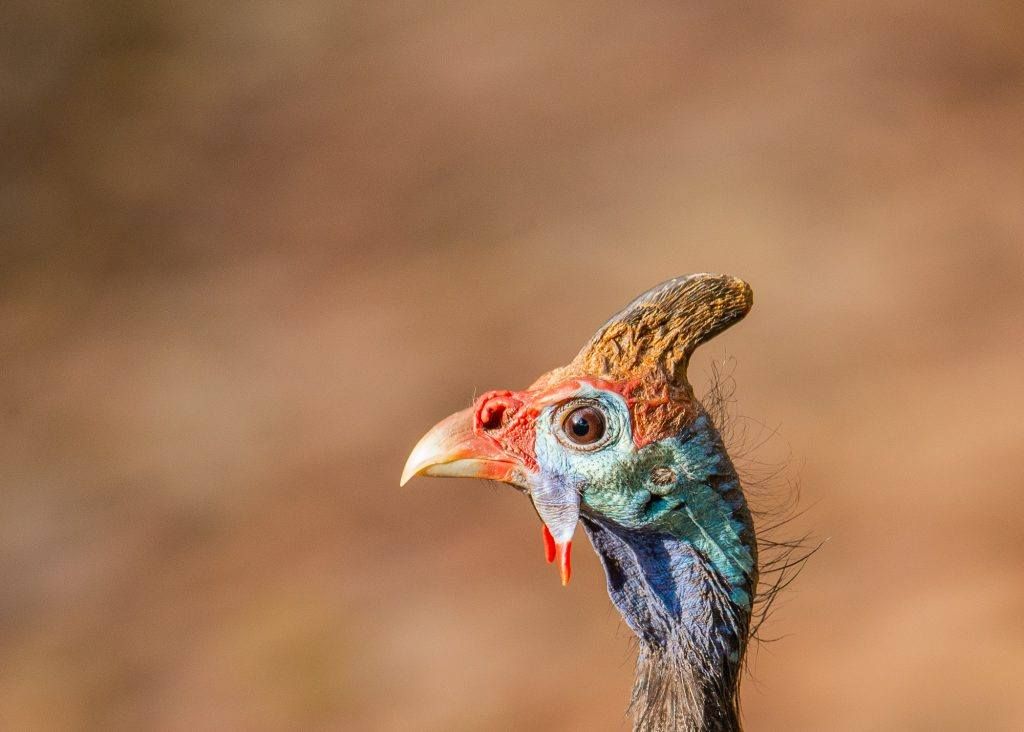
Photograph by Tobie Schalkwyk
Conclusion
One has a choice of just wandering aimlessly through life while snapping photos without meaning or to do so purposefully. There are various ways available to add meaning to your images. One of them is the increase of knowledge about your subjects.
Not only does knowledge help you to plan your photo shoots better by setting goals before a shoot, but it allows you to pre-empt a bird’s – or your – next move in order to get ‘that special shot.’
The most important factor of all: enjoy the hobby but never stop learning!
Recommended Resource: Want to expand your shooting skills and master photography? Grab our set of 65 beautifully designed and printable Action Cards that will give you over 200 photography assignments to help you take your photography to the next level. Check it out here.


